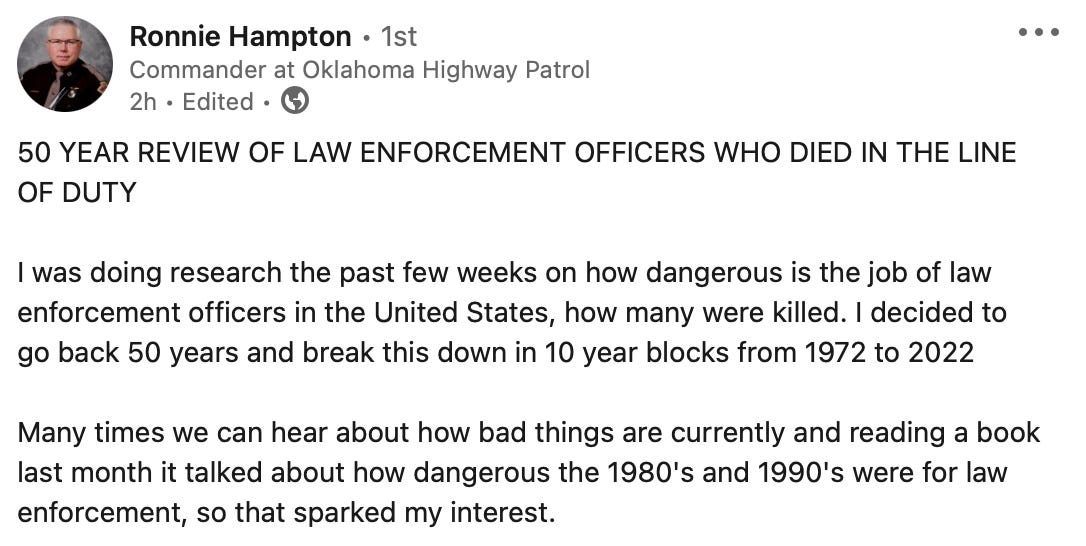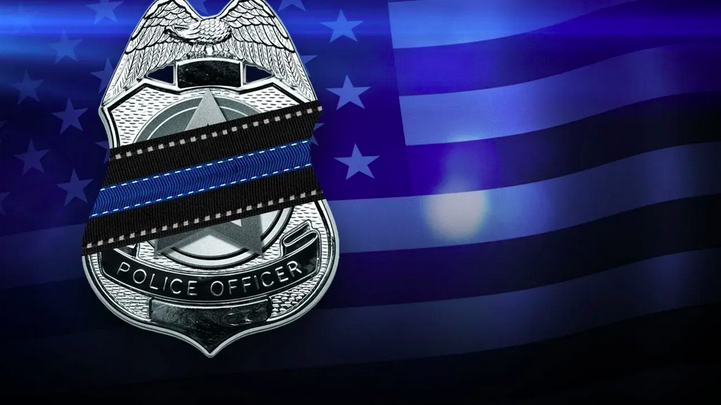For the last two decades, I have studied line of duty deaths very closely and typically pull a decade of tragedy from each individual state prior to teaching there. The Officer Down Memorial Page has, unfortunately been my second devotional of the day. Through that time, I have come to know the founder, Chris Cosgriff, pretty well and I continue to believe that what he started as an idea in college many years ago has been the greatest single contributor to officer safety in our generation.
Prior to ODMP, law enforcement had very little real time information on what was happening to officers and the FBI reports lagged a few years behind. Chris and his team of volunteers have given every law enforcement leader/trainer the ability to adapt quickly as tragedy occurs.
I recently saw a post by Oklahoma Highway Patrol Captain Ronnie Hampton where he broke down the last 50 years of law enforcement line of duty deaths. It was no small feat and I’m grateful he put in the work. I gave a few thoughts on the post and encouraged a lot smarter people to do the same.
I thought I would share my thoughts with you and I encourage you to do the same in the comments.

Killed Line of Duty
1972-1981 2329
1982-1991 1854
1992-2001 1704
2002-2011 1636
2012-2021 1378
We have seen a significant drop in overall line of duty deaths in the last 50 years and as the media loves to point out, that is why law enforcement should not focus on that pesky “warrior” training to survive. They point out that there are many more dangerous jobs such as loggers or roofers (deaths per 100,000) but as usual the media sucks at science. The last I checked, the guy roofing your home isn’t going to be shot and killed. His concern is an “accidental” death so the comparison here is ridiculous.
GET THE ‘SECONDS FOR SURVIVAL’ SEMINAR
I am certain that training and equipment, such as ballistic vests, have reduced LODD but the biggest contributor is medical technology. Citing their research, the National Institute of Health says that if we had medical technology from the 1970’s, the homicide rate (and thus, LODD) would be 5x higher. Go back another 40 years and we would be sitting at a 10x rate. A new study taking into account access to paramedics, helicopters, improved trauma centers and trained law enforcement in providing medical would likely increase that number.
The death by assault rate below has been reduced each decade, while at the same time our medical technology has also improved.
Death by Assault
1972-1981 1273
1982-1991 934
1992-2001 706
2002-2011 588
2012-2021 533
A more accurate determination at the dangers law enforcement faces is the assault rate, which often times is nothing more than an “attempted” murder. Unfortunately we do not have an accurate analysis on the overall assaults against LE. The FBI attempts to collect but almost half of represented law enforcement is not reflected because of the lack of agency participation.
The latest data shows around 60,000 officer assaults per year but it is clear that even when agencies participate in reporting the data, it is vastly underreported.
A study by the NIH found that in just a 5 year period, over 300,000 police officers were treated in an emergency room for injuries with the leading cause of assault being violence. Considering that very few officers assaulted actually go to the emergency room combined with half of the officers in the country not represented in the reporting by the FBI, the annual number of assaults is well north of 250,000 per year.
Death by Vehicle
1972-1981 246
1982-1991 201
1992-2001 310
2002-2011 327
2012-2021 231
The increase LODD with vehicles shown in the first 40 years makes some sense. We had very little training/emphasis in this area for the first 20 years of that and we added significantly more cops on the streets in the 90’s from the COPS Grant, etc. Medical technology still plays a role here, which makes the increase quite frightening but then we see a 29% drop in the last decade
That is significant enough to consider that our profession had something to do with that. To be honest, this is personal for me. I spent the first decade of my career pounding the desk (of more than one chief) about the need to train more in this area. The chiefs rarely cared but Police One took notice and I wrote a monthly article on the issue for ten years. I continue to teach a seminar called “Drive To Survive” and in 2011, I co-founded Below 100.


